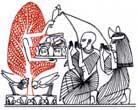|
Welsh scientists find order in chaos
There is apparently some semblance of order in the weird world of chaos after
all.
In a groundbreaking experiment, electronic engineers at the University of Wales,
Bangor have proven that with two systems in a chaotic environment, one of them
is able to anticipate a signal from the other before it is even sent.
This extraordinary saga began twelve months ago
when
a German physicist, Dr Henning Voss at the University of Freiburg,
controversially suggested that it was theoretically possible for a state of what
he called ‘anticipating synchronization’
to exist when two duplicate systems exist within a ‘chaotic’ or apparently
random environment. In simple terms he was putting forward the notion that under
such conditions it was possible for a duplicate system to anticipate changes in
the original system. It would achieve this by receiving a signal a fraction of a
second before it was actually transmitted.
However, since that time this proposition has remained no more than an
intriguing theory. That is until now. Bringing it firmly into the practical
world of reality, the team at Bangor has just announced a successful
experimental demonstration of it by using light signals transmitted by chaotic
semiconductor lasers.
In an article in this month’s Physical Review of Letters, the leading
international journal of physics, Professor Alan Shore describes how he and his
colleagues achieved this remarkable feat. He is an electronic engineer working
in the field of laser cryptography—using lasers in a chaotic state for the
secure transmission of data.
In ‘traditional’ optical transmission, lasers are used to send data
via optic fibre cables in non-chaotic form. In this mode the message travels at
the speed of light. Work in transmitting data in chaotic form is leading towards
greater security of transmission. The data is ‘wrapped’ in a chaotic signal,
which is created by using a simple mirror to reflect light back into the laser.
The data can only be deciphered at the receiver by using an identical chaotic
signal to unravel the signal. This is possible when the transmitter is used to
drive the receiver in such a way that the chaotic dynamics of transmitter and
receiver become identical. This is termed ‘chaos synchronization’.
In the first experimental demonstration of anticipating synchronization, the
laser transmitted a continuous fluctuating signal in chaotic form. The changes
in the pattern of the signal were recorded at the transmitter and receiver.
Uncannily, the receiver recorded changes in the signal nanoseconds before the
transmitter recorded the transmission of those changes—thereby anticipating
the synchronization of transmitter and receiver. The anticipation time was found
to be equal to the time of flight from the transmitter to the receiver.
“At present, we cannot fully explain our observations,” says Professor
Shore. “We had expected that the anticipation time would depend upon the time
taken for the light to travel between the laser and the external mirror which is
used to drive the laser into chaos. We are currently developing a theoretical
explanation of our observations.
“Synchronization of chaotic external cavity lasers and message transmission
and extraction has been accomplished and has been demonstrated by a number of
groups including our own,” said Professor Shore.
“In order to carry forward this concept into practical use it is now necessary
to confront basic performance issues and, in particular, to determine the rates
at which information can be transmitted. Laboratory experiments have already
confirmed the GHz message transmission capabilities of semiconductor lasers.
“One of the difficulties faced in developing the use of synchronized lasers
for secure transmission is that there is a finite ‘time of flight’ between
the transmitter and the receiver.
As the distance between transmitter and receiver is increased it could be
considered that a basic limitation on system operation can be established due to
the time it takes to synchronize the receiver and the transmitter. Indeed
previous laboratory experimental demonstrations of laser chaos synchronization
have shown that the receiver ‘lags’ the transmitter.
“What we have reproduced, however, is the state which was theorized by Voss of
the University of Freiburg, in which when working with chaotic electronic
oscillators, the receiver leads or ‘anticipates’ the transmitter.
“The work undertaken in our laboratory has provided the first experimental
confirmation of the appearance of anticipated synchronization in chaotic
external cavity lasers and indeed in any physical system. A particularly
important feature of the experimental results is the demonstration that the
‘anticipation time’ is precisely the ‘time of flight’ between the
lasers.
“The
significance of this observation for chaotic communications is immediately
apparent: operating in a regime of anticipating chaos would ensure that the
‘time of flight’ is not a fundamental constraint on system performance. We
are actively exploring a number of other issues relevant to chaotic optical
communications which follow from our observations.
“The essential feature of the chaotic laser system we have studied is the
finite time delay associated with the round-trip time of light in the laser
external cavity. We point out that finite time delays are ubiquitous.
“We would thus expect that any of those analogous systems which exhibit chaos
should also be liable to anticipating synchronization. We thus hope that our
work will act as a stimulus to explore the opportunities for observing
anticipating synchronization in physical, chemical, biological and
socio-economic systems.”
***
*** ***
PVI
6/10/2001
Source:
Bangor University
| |
|

|
Front Page
|
Editorial
|
Spiritual Traditions
|
Mythology
|
Perennial Ethics
|
Spotlights
|
Epistemology
|
Alternative Medicine
|
Deep Ecology
|
Depth Psychology
|
Nonviolence &
Resistance
|
Literature
|
Books & Readings
|
Art
|
On the Lookout
|

|
|